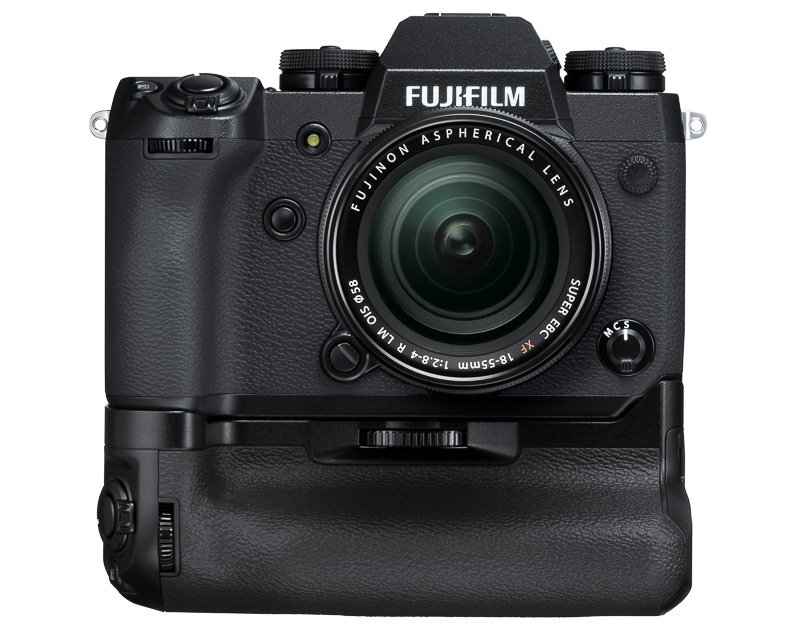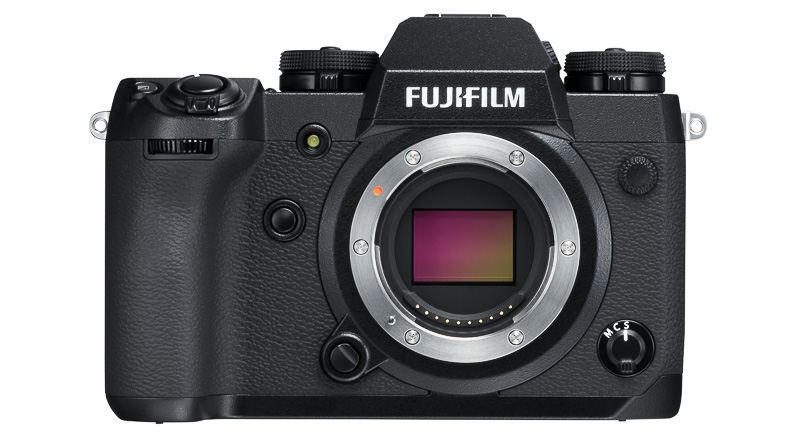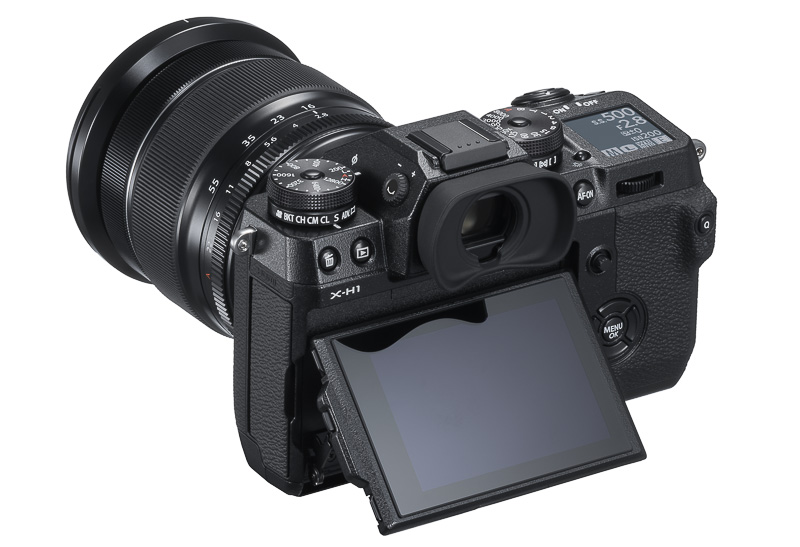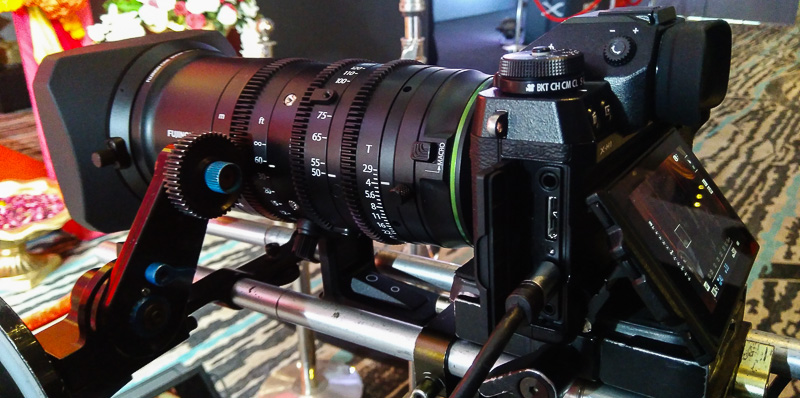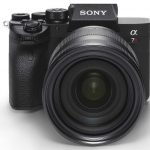Fujifilm launches X-H1 Mirrorless camera
Fujifilm today unveiled its latest professional mirrorless camera X-H1 in India in a glittering ceremony ceremony. Following is a brief firstlook impressions. Hopefully we can do a full review of the camera as it shows a lot of promise.
The Fujifilm X-H1 camera has got a 24.3 MP APS-C sized sensor (23.6mm×15.6mm ). Fujifilm calls it “X-Trans CMOS III with primary color filter”. This camera comes in the Fujifilm X mount. Being mirrorless, it is quite small as well as compared to DSLR cameras. The sensor doesn’t have an OLPF (Optical Low Pass Filter). So Fujifilm is confident about handling moire.
The body appears to have a nice rugged built using magnesium alloy. Fujifilm claims this is 25% more stronger and is weather sealed with 94 points in body and in grip. Without the grip it appears like a small rangefinder which can easily pass off as a non-serious tourist type camera and would be helpful in situations where you want to be discrete or even in some documentary situations where the respondents may get conscious or nervous at the sight of large cinema cameras.
It can shoot still images at 14 fps using electronic shutter and 8 fps while using mechnical shutter. If you use the optional grip VPB-XH1, the burst shooting rate increases to 11 fps in mechanical shutter mode. With such fast shutter speeds, photographers won’t ever feel limited while facing fast moving subjects.
Movie Shooting:
I was primarily interested in checking the Fujifilm X-H1 camera for movie shooting. It can shoot DCI 4K (4096×2160) at 24p/23.98 p at 24fps at 200Mbps. I am not sure why 25p mode is not there, as India is a PAL country and we shoot at 25p. I hope this omission of 25p in DCI 4K mode is not intentional and can be included in a future firmware update.
The X-H1 also shoots in UHD 4K (3840×2160) upto 30p and Full HD at upto 120p.
Incidentally the movie recording time in 4K and UHD 4K is only 15mins and it can go up to 30 mins if the additional vertical power booster grip is used. Unfortunately, in certain situations where we want to shoot in a discrete manner, using the vertical grip is a strict no as that would make the camera look professional. So users need to keep that in mind.
However one should also note that while shooting video if you need to monitor the sound, then you have to get the VPB-XH1 grip and it is equipped with a headphone socket.
The microphone records sound at 24bits at 48kHz. I am happy because of the 24bits sound. We nevertheless need to see how good the preamps are.
For recording movies UHD Speed Class 3 card or higher needs to be inserted in one of the two media slots.
5 Axis in body Image Stabilisation:
The good thing about this camera is the 5 axis image stabilisation in the body. It promises to be of great help during lowlight stills shooting as well as any handheld video shooting. According to Fujifilm the image stabilisation gives 5.5 stops benefit based on CIPA standard in pitch and yaw when attached with a 35mm F1.4 R lens.Up to a maximum of 5.5 stops image stabilization, is possible when the camera is used with all XF lenses that do not include optical image stabilization technology.We would have to shoot with video to understand real world impact.
The X-H1 uses three axial accelerometers, three axial Gyro sensors, and a specially developed dual-processor and is supposed to perform approximately 10,000 calculations per second. The 5-axis image stabilization is possible with all XF and XC lenses.
According to Fujifilm the following technical breakthroughs have been developed to support this high precision performance:
- A laser measurement device is used during the process of manufacturing the image stabilization unit, controlling component flatness and position with twice the precision of standard components.
- The assembly process also includes inspection and adjustment of each individual camera to ensure that even when image stabilization is used, the parallel position of the sensor is achieved with micro-order accuracy equivalent to previous models.
- In addition, a new spring mechanism has been included to reduce micro-vibrations caused by operation of the mechanical shutter.
The X-H1 has three auto ISO modes and has standard range of ISO 200 to ISO 12800. The extended ISO range is from ISO 100 to ISO 51200. It has to be seen as to how high we can push the ISO without noise. It was difficult to ascertain it during the launch. However experts of Fujifilm emphatically stated the lowlight ISO to be very good.
The X-H1 has a 0.5 inch approx. 3.69 millions dots OLED Color Viewfinder and it covers approximately 100% of the capture area.
Eyepoint: approx. 23mm (from the rear end of the camera’s eyepiece) Diopter adjustment: -4~+2m-1
Magnification: 0.75× with 50mm lens (35mm equivalent) at infinity and diopter set to -1.0m-1
Diagonal angle of view: approx. 38° (Horizontal angle of view: approx. 30° )
The LCD monitor is 3.0 inch, with an aspect ratio of 3:2. It has approx. 1.04 millions dots and is touch screen enabled color LCD monitor. The coverage here is also approx. 100%.
ETERNA film simulation for movie shooting:
The X-H1 is the first camera in the X Series to include ETERNA, a new film simulation ideal for shooting movies. This mode simulates cinematic film, creating understated colors and rich shadow tones, greatly enhancing creative freedom during post-processing. The camera’s video image quality has been improved through the new ability to record a high bit rate of 200 Mbps. Having grown up with Fuji Velvia and Provia slide films, I always appreciate the Fuji colours. Many users are going to find very less colour correction due to this. Fujifilm has included recording in log mode termed as “F-log” when you need more push and pull in post-processing or when you are trying to match with other cameras.
Future Lens releases:
The Fujifilm X-H1 camera is also compatible with a range of other interchangeable lenses which are scheduled for release later this year. These include the MKX18-55mmT2.9 and MKX50-135mmT2.9 professional cinema lenses incorporating the X mount which are scheduled for release in May 2018. The new camera and lens combinations will provide outstanding image production and will be ideal for shooting a moving subject.
The X-H1 body weighs 673 gms with battery and card.
Price: The Fujifilm: X-H1 is priced at Rs.149,999/- (Body Only) and Rs.172,999/- (Body and Battery Grip).
Fujifilm has got extensive highend cinema lenses. So it was interesting to see Fujinon lens mated to a X-H1 showing the potential to serve as additional camera in bigger productions. Since this camera launch was done within a week of its global launch, it indicates seriousness of the Fujifilms management. And that is what is expected by customers.
PRESS RELEASE:
Fujifilm India Raises the Curtain on the elite X-H1, the most awaited high performance camera in the X Series Range
New Delhi, 22 February 2018: Fujifilm India Private Limited, a pioneer in imaging technologies, is delighted to announce the launch of the opulent FUJIFILM X-H1, the highest performance mirrorless digital camera in the X Series known for its superior image quality created by Fujifilm’s proprietary color reproduction technology.
The X-H1, with a newly-designed robust and durable body, incorporates a range of extremely useful features that support shooting in various scenarios demanded by professional photographers and videographers. The X-H1 is the first X Series model to include the latest 5-axis in-body image stabilization (IBIS), which has a maximum of 5.5 stops*. The superior image quality with the memory color will be achieved in the various scenes in addition to easy operation. It is also mounted with the flicker reduction mode which enhances the quality of indoor sports photography. In addition, The X-H1 is the first camera in the X Series to include ETERNA mode, a new film simulation mode ideal for shooting movies. The X-H1 is priced at Rs.149,999/- (Body Only) and Rs.172,999/- (Body and Battery Grip).
*1 With XF 35mmF1.4 lens attached
The camera is also compatible with a range of other interchangeable lenses which are scheduled for release later this year. These include the MKX18-55mmT2.9 and MKX50-135mmT2.9 professional cinema lenses incorporating the X mount which are scheduled for release in May 2018. The new camera and lens combinations will provide outstanding image production and will be ideal for shooting a moving subject in sports photography.
Commenting on the occasion, Mr. Haruto Iwata, Managing Director, Fujifilm India Pvt. Ltd. said, “Professional photography in India is gaining momentum and we see immense potential in this market. The Wedding, Advertising, Broadcast and Digital mediums are evolving at a fast pace in India due to which there is a huge demand for superior image quality. With X-H1 we are offering a level of imaging performance that is simply unmatched by any camera ever created. The X-H1 will certainly mark a milestone for us in India, as we believe this is a camera that certainly exceeds professional expectations.’’
Adding further ‘’Fujifilm means value for innovation; our aim is to offer a perfect package of efficient workflow and professional reliability. With the vision to capture No. 1 market share in the premium mirrorless camera market by 2019 we will continue to evolve by offering outstanding image quality and advance features that will always exceed expectations.’’
Standout features
- 5.5 stops (*1) in-body image stabilization (IBIS), a new feature expanding the high-quality photographic range of the X Series.
The first internal in-body image stabilization (IBIS) system to feature in an X Series camera, harnesses three axial accelerometers, three axial Gyro sensors, and a specially developed dual-processor. Combined, this achieves the high speed of approximately 10,000 calculations per second. When unified with compensating mechanisms, results in uncompromising image quality and precision with performance as described below.
(1) 5-axis image stabilization is possible with all XF and XC lenses.
(2) Up to a maximum of 5.5 stops image stabilization, is possible when the camera is used with all XF lenses that do not include optical image stabilization technology.
The following technical breakthroughs have been developed to support this high precision performance:
- A laser measurement device is used during the process of manufacturing the image stabilization unit, controlling component flatness and position with twice the precision of standard components.
- The assembly process also includes inspection and adjustment of each individual camera to ensure that even when image stabilization is used, the parallel position of the sensor is achieved with micro-order accuracy equivalent to previous models.
- In addition, a new spring mechanism has been included to reduce micro-vibrations caused by operation of the mechanical shutter.
- The photographer may also choose to use the electronic front curtain shutter or the electronic shutter, virtually eliminating the effect of vibrations to maximize the benefits of image stabilization.
The X-H1 uses the APS-C size X-Trans™ CMOS III (*3) sensor (24.30 million pixels, without low-pass filter) and the high-speed image processing engine X-Processor Pro. This proprietary FUJIFILM technology was first seen in the X-Pro2 and then X-T2 cameras, receiving many awards globally. When used in combination with the extremely high-quality FUJINON lens, as well as the unique color reproduction technology developed by FUJIFILM more than 8 decades ago, the X-H1 produces outstanding, unrivaled quality images recording the finest details of the subject including its texture, three-dimensional structure and even the atmosphere and vibe of a particular scene.
*3 X-Trans is a trademark or registered trademark of FUJIFILM. The X-Trans CMOS III sensor uses a unique non-periodic filter array to reduce the appearance of moire patterns and false colors even without an optical low-pass filter.
- Highly robust, durable body and easy operability results in comfortable shooting across a wide range of environments
(1) In addition to the camera’s dust-resistant, water-resistant properties, and the ability to operate in temperatures down to -10°C, the camera also uses a 25% thicker magnesium alloy compared to the X-T2. FUJIFILM has also modified the structure for attaching the mount, resulting in a more compact size and lighter weight body that maintains high precision and strong resistance to impact shock torsion and other sources of deformation.
Increased particle size on the camera’s external surface provides a high-quality scratch-resistant coating with a surface hardness equivalent to 8H.
(2) The viewfinder is a high-magnification, high-precision electronic viewfinder. The magnification ratio of 0.75 times and the 3.69 million resolution leads the class for mirrorless cameras. The viewfinder display is extraordinarily smooth, with a display time lag of just 0.005 seconds and a frame rate of 100 frames per second, allowing the photographer to instantly confirm the movement of the subject and position of the focus with great precision.
The rear LCD monitor is a 3-direction tilt, 3-inch, 1.04 million dot electrostatic touch-panel LCD which can be intuitively set to the desired angle. In addition, the 1.28 inch sub-LCD on the top of the camera, a current feature of the medium format FUJIFILM GFX 50S, allows for instant confirmation of shooting information.
(3) Improved operability with a total of 19 modifications based on feedback from professional photographers
- The camera uses a large-grip design with the new shape and a leaf-spring switch for the shutter-release button to achieve a stable feel when holding the camera and easy operation of the shutter-release button to ensure no opportunities are missed.
- The camera has the quietest shutter sound of all cameras in the X Series, making it an ideal tool for environments where quietness is required such as when shooting animals in the wild, quiet performances or at weddings.
- A new AF-ON button has been added to the back of the camera. This makes it easier to operate the autofocus with the thumb, allowing the photographer to focus on using their index finger to operate the shutter-release button. In addition, other modifications have been made to improve operability, including the enlargement of the buttons on the rear of the camera and improvements to the grip of the front and rear command dials.
- The X-H1 also features focus lever that facilitates rapid, accurate movement to the desired focus point.
- The first flicker reduction mode on an X Series camera and improved AF algorithms enhance shooting toughness
Flicker reduction modes are essential for indoor sport photography, and the X-H1 achieves this using a mirrorless camera, allowing for stable exposure during burst shots even under fluorescent and mercury lighting.
In addition, improvements to the AF algorithm have achieved the following performance enhancements:
- The low-light limit for phase detection autofocus has been improved by approximately 1.5 stops from 0.5EV to -1.0EV, raising the precision and speed of autofocus in low-light environments.
- The range at minimum aperture has been expanded from F8 to F11.
For example, even when using the XF100-400mmF4.5-5.6 R LM OIS WR with the teleconverter XF2X TC WR, phase detection autofocus can now be used.
- Major improvements have been made to the AF-C performance while operating the zoom, which provides major benefits when shooting sports and other scenarios in which the subjects moves unpredictably.
- Subjects where results with phase detection autofocus were previously poor, such as finely-detailed surface textures; wild birds and wild animals, can now be captured at high speed and with high precision.
- Comprehensive range of video features to support movie production requirements
The X-H1 is the first camera in the X Series to include ETERNA, a new film simulation ideal for shooting movies. This mode simulates cinematic film, creating understated colors and rich shadow tones, greatly enhancing creative freedom during post-processing. The camera’s video image quality has been improved through the new ability to record a high bit rate of 200 Mbps. The camera includes a total of 20 functional and performance improvements including the 1080/120P high-speed video mode (1/2, 1/4 and 1/5 speed slow motion) for recording spectacular slow-motion footage, F-log*4 SD card recording which aids smooth workflow, a DCI 4K shooting mode (4096×2160), a 400% dynamic range setting (approximately 12 stops), 200 Mbps high bit rate recording, a high-sound quality internal microphone (24 bit/48 kHz) and verbal time codes.
*4 The color space is defined according to ITU-R BT.2020.
- Separate accessories
(1)Vertical power boost grip VPB-XH1 *Exclusive for the X-H1
- Dust-resistant and water-resistant operates at temperatures of down to -10°C. Two batteries may be attached, with a third battery in the body of the camera increasing the maximum number of available shots in normal mode to approximately 900. In boost mode, multiple batteries can be used simultaneously, improving performance for burst shots and reducing the interval between shots, shutter time lag, and the blackout period.
In addition, the accessory also increases the maximum period for shooting movies in 4K to about 30 minutes, making the VPB-XH1 an essential accessory for maximizing the performance of the X-H1.
- Controls include the shutter-release button, focus lever, AE-L button, AF-ON button, command dial, Q button, and Fn button, providing the same easy operation when using the camera in both the vertical and horizontal positions.
- The VPB-XH1 is equipped with a headphone socket, allowing the operator to monitor sound while recording video.
- The grip also includes recharging capability. The included AC adapter (AC-9VS) can be used to recharge two batteries simultaneously over approximately 2 hours.
(2) Wide-eye cup EC-XH-W *Common for X Series and GFX cameras
The wide cup covers a broad area around the eye, greatly reducing light interference and enhancing concentration during long shoots.
The eye cup can also be rotated in 90° increments, making it adaptable for either the left eye or the right eye and for shooting in either vertical or horizontal position. The cup also includes antistatic coating, reducing the adherence of dust.
- FUJIFILM X-H1 specification
| Model name | FUJIFILM X-H1 | |
| Number of effective pixels | 24.3 millions pixels | |
| Image sensor | 23.6mm×15.6mm (APS-C) X-Trans CMOS III with primary color filter. | |
| Sensor cleaning system | Ultra Sonic Vibration | |
| Storage media | SD Card (~2GB) / SDHC Card (~32GB) / SDXC Card (~256GB) UHS-I / UHS-II*1 | |
| Lens mount | FUJIFILM X mount | |
| Image Stabilizer | Mechanism | Image sensor shift mechanism with 5-axis compensation |
| Compensation Effect | 5.5 stops (based on CIPA standard. Pitch/yaw shake only. With XF35mmF1.4 R lens mounted. | |
| Sensitivity | Standard output | AUTO1 / AUTO2 / AUTO3 (up to ISO12800) / ISO200~12800 (1/3 step) |
| Extended output | ISO100/125/160/25600/51200 | |
| Viewfinder | 0.5 inch approx. 3.69 millions dots OLED Color Viewfinder
Coverage of viewing area vs. capturing area: approx. 100% Eyepoint: approx. 23mm (from the rear end of the camera’s eyepiece) Diopter adjustment: -4~+2m-1 Magnification: 0.75× with 50mm lens (35mm equivalent) at infinity and diopter set to -1.0m-1 Diagonal angle of view: approx. 38° (Horizontal angle of view: approx. 30° ) Built-in eye sensor |
|
| LCD monitor | 3.0 inch, aspect ratio 3:2, approx. 1.04 millions dots touch screen color LCD monitor(approx. 100% coverage) | |
| Continuous shooting | 14.0 fps (with the Electronic Shutter), 8.0 fps (with the Mechanical Shutter)
11.0 fps (with the Mechanical Shutter and when fitted with VPB-XH1) |
|
| Movie recording | [4K (4096×2160)] 24P / 23.98P up to approx. 15min.
[4K (3840×2160)] 29.97P / 25P / 24P / 23.98P up to approx. 15min. [Full HD (1920×1080)] 59.94P / 50P / 29.97P / 25P / 24P / 23.98P up to approx. 20min. [HD (1280×720)] 59.94P / 50P / 29.97P / 25P / 24P / 23.98P up to approx. 30min. *For recording movies, use a card with UHS Speed Class 3 or higher. *With Vertical Power Booster Grip attached, individual movie recording time is extended up to approx. 30min. on both 4K and Full HD mode. |
|
| Wireless transmitter | Standards: IEEE 802.11b / g / n [standard wireless protocol]
Access mode: Infrastructure Encryption: WEP / WPA / WPA2 mixed mode |
|
| Bluetooth® | Standard: Bluetooth Ver. 4.0(Bluetooth® low energy)
Operating frequency (Center frequency): 2402~2480MHz |
|
| Power supply | NP-W126S Li-ion battery (included) | |
| Dimensions / Weight | ((W) 139.8mm × (H) 97.3mm × (D) 85.5mm (minimum depth 39.5mm)
Approx. 673g (including battery and memory card) Approx. 623g (excluding battery and memory card) |
|
| Battery life for still images
*2 |
Approx. 310frams (Normal Mode) When XF35mmF1.4 R is set. | |
| Accessories included | Li-ion battery NP-W126S, Battery charger BC-W126, Shoe-mount flash unit EF-X8, Shoulder strap, Body cap, Strap clip, Protective cover, Clip attaching tool, Hot shoe cover, Vertical Power Booster Grip connector cover, Sync terminal cover, Cable protector Owner’s manual | |
*1 Please see the Fujifilm website (http://www.fujifilm.com/support/digital_cameras/compatibility/card/x/) to check memory card compatibility.
*2*Measured according to the CIPA standards, using the included battery and an SD card. The number of frames that can be taken per charge varies depending on a battery’s charge capacity.
This figure is not a guarantee of battery’s working capacity. At low temperatures, the number of frames per charge decreases.
If you are one of our international readers you can Buy using this link:-
B&H https://www.bhphotovideo.com/c/product/1388297-REG/fujifilm_16568731_x_h1_mirrorless_digital_camera.html/BI/13252/KBID/19990
- GoPro Hero 12 Black - 6 September,2023
- Leopards: The Last Stand - 2 July,2023
- Drifting in the Waters of Sundarbans - 26 March,2023

